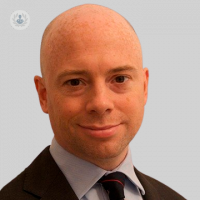Treating vitreoretinal conditions in children
Written by:If your child has an eye problem that is causing damage to their retina or its blood supply, they may need surgical treatment to prevent serious loss of vision. We spoke to leading consultant paediatric ophthalmic surgeon Mr Robert Henderson about how surgery for this type of condition works – and how modern techniques are making all the difference.

What does 'vitreoretinal' mean?
'Vitreoretinal' refers to conditions that affect the retina and vitreous, two parts of your eye.
The retina is the membrane at the back of the eye that turns light into electrical signals - like the film in the camera. The vitreous is the gel in front of the retina, and in childhood is very adherent to the retina. The blood supply to the retina is vital - it needs more oxygen than any other tissue in the body.
What vitreoretinal conditions occur in children?
Many paediatric vitreoretinal conditions involve disorders in the formation of either the retina, its blood supply, or the vitreous gel. These conditions are divided into congenital conditions (those that you are born with or develop soon after birth) and acquired retinal diseases (which can happen at any time during childhood).
The vast majority of the conditions that we see are genetic in basis and include congenital diseases such as:
- familial exudative vitreo-retinopathy (FEVR)
- persistent foetal vasculature (PFV)
- incontinentia pigmenti (IP)
- Coat's disease
In addition, some babies who are born extremely early can acquire a condition known as retinopathy of prematurity.
Read more: What is retinopathy of prematurity?
In any of these conditions, the retina can end up being dragged or detached by abnormal blood vessels that act like 'guy-ropes' on a tent. If left untreated, babies and young children will often end up blind, or severely visually impaired.
How are vitreoretinal conditions treated?
One of the key treatments for this kind of condition is a vitrectomy. A vitrectomy is the process of removing the clear vitreous gel that fills the back of the eye.
These days, this is usually performed with the surgeon using a ‘light pipe’, or endoscope. This is inserted into the eye and a microscope-based viewing system is used to see through the pupil back to the retina. We also call this endoscopy-assisted vitrectomy surgery.
The endoscope device is used to see into the eye and visualise parts of the eye that are usually hidden by the iris. These particular optics also allow the surgeon to view the ‘guy-ropes’, described earlier, in a way that cannot be seen with traditional microscope viewing systems. If we can view these bands that are dragging, distorting, and detaching the retina we can cut them, and allow the retina to settle back down.
In addition, patients may have conditions that prevent any view of the retina, and in these instances the endoscope is invaluable in allowing surgery to be performed.
Which conditions benefit most from this technique?
The most important use is for the treatment of retinopathy of prematurity where the transvitreal bands can be visualised clearly and cut, permitting the retina to settle back.
It is also useful for treating trauma cases, and in patients where there is no clear cornea to allow the retinal detachment to be viewed. Some endoscopes also have a laser facility which permits treatment of glaucoma (raised pressure inside the eye) in certain cases.
If you would like to book a consultation with Mr Henderson to discuss vitreoretinal treatment for your child, you can do so via his Top Doctors profile.


